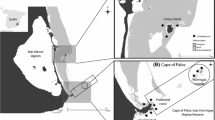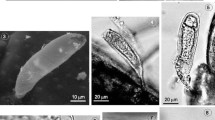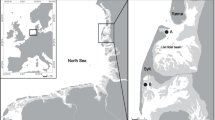Abstract
We examined the species composition of red king crab (Paralithodes camtschaticus) fouling communities in Dolgaya Bay, a small fjord of the Barents Sea, in August 2005 and 2006. In total, there were 13 species observed on 301 crabs collected from water depths of 5–90 m. Barnacles (Balanus crenatus; prevalence 42.9%) and blue mussels (Mytilus edulis; 11.6%) were the most common epibionts, while amphipods (Ischyrocerus commensalis) were the most common symbionts (28.6%). Infestation rates in Dolgaya Bay were different from those in an “open” area of the Barents Sea (Dalnezelenetskaya Bay), probably due to differences in hydrodynamic conditions. Differences in infestation prevalence and intensity were detected neither between male and female crabs nor between crabs collected at 5–35 m versus 90 m depths. Prevalence of common fouling species increased with host size. Amphipods I. commensalis colonized the carapace and limbs in Dolgaya Bay less frequently than in Dalnezelenetskaya Bay, probably due to interspecific competition with barnacles occupying the dorsal parts of the host. Juvenile barnacles and mussels dominated the fouling communities on the crabs. The age of barnacles did not exceed 2–4 months. However, the presence of 4-year-old mussels suggests that these older mollusks have been directly transferred from mussel beds to the hosts. Our results indicate that colonization by epibionts and symbionts is generally not disadvantageous for the crab hosts, except for some possible negative impacts of amphipods occupying the gills.





Similar content being viewed by others
References
Anisimova NA, Frolova EA (1994) Benthos of the Dolgaya bay in the eastern Murman. Composition, quantative distribution. In: Matishov GG (ed) Hydrobiological researches in the Gulfs and Bays of the northern seas of Russia (in Russian). KSC RAS, Apatity, pp 61–92
Bakay YI, Kuzmin SA, Utevsky SYu (1998) Ecological and parasitologic investigations on the Barents sea red king crab Paralithodes camtschaticus (the first results). ICES CM 1998/AA 4:14
Barnes H, Bagenal TB (1951) Observations on Nephrops norvegicus (L.) and on an epizoic population of Balanus crenatus Brug. J Mar Biol Assoc U K 30:369–380
Boyko CB, Mikkelsen PM (2002) Anatomy and biology of Mysella pedroana (Mollusca, Bivalvia, Galleomatoidae) and its commensal relationship with Blepharipoda occidentalis (Crustacea, Anomura, Albuneidae). Zool Anz 241:149–160. doi:10.1078/S0044-5231(04)70070-4
Brattegard T (1980) Why biologists are interested in fjords. In: Freeland HJ, Farmer DM, Levings CD (eds) Fjord oceanography. Plenum Press, New York, pp 53–66
Dick MH, Donaldson WE, Vining IW (1998) Epibionts of the tanner crab Chionoecetes bairdi in the region of Kodiak Island, Alaska. J Crustac Biol 18:519–528. doi:10.2307/1549416
Donaldson WE, Byersdorfer SE (2005) Biological field techniques for Lithodid crabs. Fairbanks. Alaska Sea Grant College Program, University of Alaska, Alaska
Dvoretsky AG (2008) Biological features of the red king crab in eastern Murman. In: Matishov GG (ed) Biology and physiology of the red king crab from the coastal zone of the Barents sea (in Russian). KSC RAS, Apatity, pp 22–60
Dvoretsky AG, Dvoretsky VG (2008a) Epifauna associated with the northern stone crab Lithodes maia in the Barents sea. Polar Biol 31:1149–1152. doi:10.1007/s00300-008-0467-3
Dvoretsky AG, Dvoretsky VG (2008b) Fouling community of the red king crab in the Sayda inlet of the Barents sea. In: Marine coastal ecosystems. seaweeds, invertebrates and products of their processing: abstracts of Third International conference, TINRO-Center, Vladivostok, p 50
Dvoretsky AG, Dvoretsky VG (2009) Some aspects of the biology of the amphipods Ischyrocerus anguipes associated with the red king crab, Paralithodes camtschaticus, in the Barents sea. Polar Biol 32:463–469. doi:10.1007/s00300-008-0541-x
Dvoretsky AG, Frolova EA, Kuzmin SA (2006) Symbiotic polychaetes of the Kamchatka crab Paralithodes camtschaticus in the Barents sea (in Russian). In: Proceedings of the IX congress Hydrobiological Society RAS, Part 1, p 128
Dvoretsky AG, Kuzmin SA, Matishov GG (2007) The biology of the amphipod Ischyrocerus commensalis and its symbiotic relationships with the red king crab in the Barents sea. Dokl Biol Sci 417:453–455. doi:10.1134/S0012496607060129
Gannon AT, Wheatly MG (1992) Physiological effects of an ectocommensal gill barnacle, Octolasmis mülleri, on gas exchange in the blue crab Callinectes sapidus. J Crustac Biol 12:11–18. doi:10.2307/1548714
Giri T, Wicksten MK (2001) Fouling of the caridean shrimp, Lysmata wurdemanni (Gibbes 1850) by the barnacle, Balanus improvisus Darwin 1854 and other epibionts. Crustaceana 74:1305–1314. doi:10.1163/15685400152885255
Jansen PA, Mackenzie K, Hemmingsen W (1998) Some parasites and commensalis of red king crab Paralithodes camtschaticus in the Barents sea. Bull Eur Assoc Fish Pathol 18:46–49
Key MM, Winston JE, Volpe JW, Jeffries WB, Voris HK (1999) Bryozoan fouling of the blue crab Callinectes sapidus at Beaufort, north Carolina. Bull Mar Sci 64:513–533
Klitin AK (2003) The red king crab along the shores of Sakhalin and the Kuril Islands: biology, distribution, and functional structure of the area (in Russian). Natsrybresursy, Moscow
Kuris AM, Blau SF, Paul AJ, Shields JD, Wickham DE (1991) Infestation by brood symbionts and their impact on egg mortality of the red king crab, (Paralithodes camtschatica) in Alaska. Can J Fish Aquat Sci 48:559–568
Kuzmin SA, Gudimova EN (2002) Introduction of the Kamchatka (Red king) crab in the Barents sea. Pecularities of biology, perspectives of fishery (in Russian). KSC RAS, Apatity
Kuznetsov VV (1964) The biology of abundant and the most common species of crustaceans in the Barents and White seas (in Russian). Nauka, Moscow
Matveeva TA (1948) The biology of Mytilus edulis L. the eastern Murman. In: Kluge GA (ed) Trudy of the Murmansk biological station (in Russian). Akad Nauk SSSR, Moscow, Leningrad, pp 215–241
McGaw IJ (2006) Epibionts of sympatric species of Cancer crabs in Barkley sound, British Columbia. 2006. J Crustac Biol 26(1):85–93. doi:10.1651/C-2601.1
Pettibone MH (1963) Marine polychaete worms of the New England region: I. Families Aphroditidae through Trochochaetidae. Bull US Natl Mus 227(1):1–356
Rzhepishevskiy IK (1963) Barnacles reproduction in the eastern Murman (in Russian). PhD Dissertation. Murmansk Marine Biological Institute, Dalnie Zelentsy
Sainte-Marie B, Berube I, Brillon S, Hazel F (2006) Observations on the growth of the sculptured shrimp Sclerocrangon boreas (Decapoda: Caridea). J Crustac Biol 26:55–62
Savoie L, Miron G, Biron M (2007a) Fouling community of the snow crab Chionoecetes opilio in Atlantic Canada. J Crustac Biol 27:30–36. doi:10.1651/S-2722.1
Savoie L, Miron G, Biron M (2007b) Fouling community of the snow crab Chionoecetes opilio in Sydney Bight, Canada: preliminary observations in relation to sampling period and depth/geographical location. Cah Biol Mar 48:347–359
Sloan NA (1984) Incidence and effects of parasitism by the rhizocephalan barnacle, Briarosaccus callosus Boshma, in the golden king crab, Lithodes aequispina Benedict, from deep fjords in northern British Columbia, Canada. J Exp Mar Biol Ecol 84:111–131. doi:10.1016/0022-0981(84)90205-3
Sokolov VI, Milyutin DM (2006) Distribution, size-sex composition, and reserves of the red king crab (Paralithodes camtschaticus) in the upper sublittoral of the Kola Peninsula (the Barents sea) (in Russian). Zool Zh 85:158–171
Talberg NB (2005) Comparative characteristics in the red king crab migration pattern in the shallows of the Barents and Okhotsk seas. In: Pereladov MV (ed) Coastal hydrobiological investigations: VNIRO Proceedings, Vol 144 (in Russian). VNIRO, Moscow, pp 91–101
Utevsky SY, Kuzmin SA, Dvoretsky AG (2006) Leeches (Hirudinida: Piscicolidae) commensals of the red king crab Paralithodes camtschaticus. In: Matishov GG (ed) Current state of crabs’ populations in the Barents sea and their interaction with bottom biocenoses (in Russian). MMBI KSC RAS, Murmansk, pp 104–106
Villegas MJ, Stotz W, Laudien J (2006) First record of an epibiosis between the sand crab Emerita analoga (Stimpson, 1857) (Decapoda: Hippidae) and the mussel Semimytilus algosus (Gould, 1850) (Bivalvia, Mytilidae) in southern Peru. Helgol Mar Res 60:25–31. doi:10.1007/s10152-005-0012-5
Voronkov PP, Uralov NS, Chernovskaya EN (1948) Common aspects of hydrochemical regime of the coastal zone of the Barents sea near central Murman. In: Kluge GA (ed) Trudy of the Murmansk biological station (in Russian). Akad Nauk SSSR, Moscow, Leningrad, pp 39–101
Wahl M (1989) Marine epibiosis. I. fouling and antifouling: some basic aspects. Mar Ecol Prog Ser 58:175–189. doi:10.3354/meps058175
Williams JD, McDermott JJ (2004) Hermit crab biocoenoses: a worldwide review of the diversity and natural history of hermit crab associates. J Exp Mar Biol Ecol 305:1–128. doi:10.1016/j.jembe.2004.02.020
Zar JH (1999) Biostatistical analysis, 4th edn. Prentice-Hall, Upper Saddle River
Zhivogljadova LA (2006) Parasites and epibionts of the golden king crab Lithodes aequispinus, Benedict of the Kuril Islands (in Russian). In: Proceedings of IX congress of Hydrobiological Society of Russian Academy of Sciences, Part 1, p 158
Acknowledgments
We thank to S. A. Kuzmin and T. A. Britayev for the organization of the research logistics and sampling and their valuable discussions. We are grateful to E. A. Frolova, N. N. Panteleeva and E. N. Nikulina who helped in identification of polychaete and hydrozoan species. Our special thanks are due to J. Muehlbauer, D. Piepenburg, M. M. Kalin and C. Sierra for English corrections. M. Biron, I. J. McGaw and an anonymous referee provided excellent criticisms to improve this paper.
Author information
Authors and Affiliations
Corresponding author
Rights and permissions
About this article
Cite this article
Dvoretsky, A.G., Dvoretsky, V.G. Fouling community of the red king crab, Paralithodes camtschaticus (Tilesius 1815), in a subarctic fjord of the Barents sea. Polar Biol 32, 1047–1054 (2009). https://doi.org/10.1007/s00300-009-0604-7
Received:
Revised:
Accepted:
Published:
Issue Date:
DOI: https://doi.org/10.1007/s00300-009-0604-7




